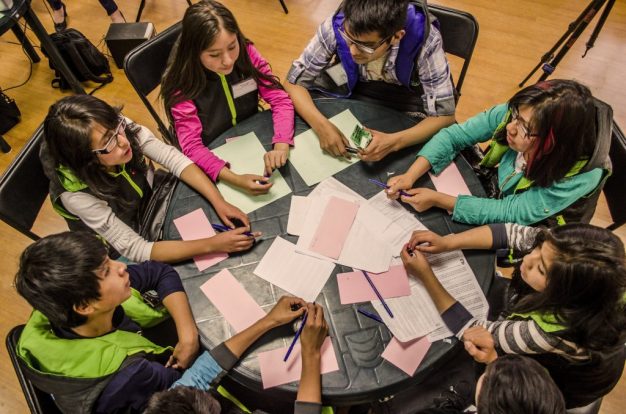
Participation can draw out the strength to tackle problems
In the second part of her reflection on the children’s participation theme at the recent international seminar on urban planning, Karine Van ‘t Land suggests that a synthesis of two different approaches may provide the most effective support to children and their communities.
In contrast to the problems-based approach advocated by Tim Gill, the other speakers on child participation at the Rotterdam seminar expanded on approaches that explicitly refused to focus on problems as their point of departure. Willem van Vliet (emeritus professor in urban sociology, university of Colorado, US) and Ivet Pieper (Alexander Foundation, NL) each made cases for what might be called a strengths-based approach.
In his work for child participation in the university town of Boulder, Colorado, Van Vliet has seen more than enough problems: drug abuse, teen pregnancy, crime, and so on. Through a focus on problems, problems become bigger, whereas children and young people are turned into passive, vulnerable recipients of care; creatures without strength or resilience. If adults view children in this manner, children indeed lose strength.
Emphasising the good
Pieper spoke about her work with children in poor neighbourhoods in Amsterdam, which outsiders typically view as being full of problems. Pieper finds it essential to provide ample space for the children to report the good things in their community, and to feel proud and strong. A focus on problems intensifies the burden of stigmatisation and undermines strength.
These two speakers also agreed on their preference for making the voices of children heard, even if these children do not say radically ‘new’ things. Van Vliet devotes much energy to ensure that children can effectively express their views on their environment, urban planning and public transport. He finds it valuable to work from their fine-grained testimonies and suggestions.
Pieper engages children and young people as co-researchers. As she remarked, the results may not be interesting from a strictly scientific point of view. Yet, it means a lot for the children involved to be able to set the agenda, to influence the course of action and to evaluate the results. They gain strength through the process.
People-power
Now, which approach would be best if we want to create child friendly cities: a problem-based or a strength-based approach? I think we would fail to do justice to Gill’s plea if we reduced his problem-based approach to a kind of stigmatising negativity. Gill says the ‘people-power’ of effective activists derives from their focus on clearly identified problems. He portrays this approach as a kind of collective rallying cry: ‘This is an insult to human dignity. Together we have to step up and deal with this problem.’
Pieper and Van Vliet speak about how to support people who may not have the energy, or the confidence for such activism, even though they are surrounded by problems. There seems to be a crucial difference between the angry Dutch mothers from the 70s – campaigning very effectively for a more cycle-friendly traffic system – and the inhabitants of poor neighbourhoods where Pieper and Van Vliet work.
The difference might be a sense of belonging. Many people in poor neighbourhoods are pressured by the burden of stigmatisation and negative stereotyping. This pressure reduces their human dignity little by little, day in day out. If people face their problems, they do not feel activated or invited to make their opinions heard. They feel ashamed, frightened, humiliated or simply overwhelmed, becoming more passive and less capable of solving problems.
Transformative
Pieper and Van Vliet’s positive and activating forms of participation are meant to lead people out of the impasse of stigmatising problems. Careful listening and a genuinely positive approach can enhance self-assurance, increase strength, build and sustain a sense of human dignity. Perhaps, step-by-step, the strength-based approach to participation can lead to a situation where a problem-based approach does work; in which people are able to face their problems without fear or shame, and in which they work together in order to bring about change. Children might be the first to adopt such a transformative approach.
Karine van ’t Land
Photo: ECPAT International
 Karine van ’t Land, who facilitated the children’s participation workshop at the Rotterdam seminar, is a public health physician specialising in preventive child care. She is currently finishing her PhD at the Humanities Department, Radboud University, Nijmegen. She has been a project leader in children’s participation work for the City of Rotterdam.
Karine van ’t Land, who facilitated the children’s participation workshop at the Rotterdam seminar, is a public health physician specialising in preventive child care. She is currently finishing her PhD at the Humanities Department, Radboud University, Nijmegen. She has been a project leader in children’s participation work for the City of Rotterdam.




